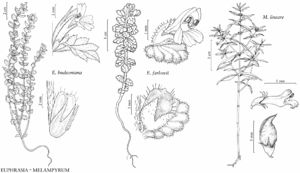Melampyrum lineare
in J. Lamarck et al., Encycl. 4: 22. 1797.
Annuals 5–40 cm; branches 1–3(–5) pairs, opposite, rarely with secondary branches. Leaves: blade linear to ovate, 13–55 x 2–22 mm, puberulent. Inflorescences: flower pairs 4–10; bracts resembling foliage leaves or with 1 or 2 pairs of proximal teeth. Pedicels 0–3(–5) mm. Flowers: calyx 3–5 x 2–3 mm, lobes equal to tube, often reflexed, adaxial slightly longer than abaxial; corolla 10–14 x 3–4 mm, abaxial lip with palate yellow and divided by a longitudinal groove, sinuses 1–2 mm, lanose within; anthers included in adaxial lip, hairy. Capsules 6–9 x 3–5 mm, +/- falcate, compressed. Seeds 2–4 x 0.5–1 mm, testa smooth. 2n = 18.
Phenology: Flowering May–Sep; fruiting Jul–Oct.
Habitat: Coniferous and deciduous forests, sandy glades, gravelly terraces, heaths, rocky barrens, coastal headlands, dry meadows, peatlands, fens, roadsides.
Elevation: 0–2000(–3000) m.
Distribution
St. Pierre and Miquelon, Alta., B.C., Man., N.B., Nfld. and Labr. (Nfld.), N.S., Ont., P.E.I., Que., Sask., Conn., Del., Ga., Idaho, Ill., Ind., Ky., Maine, Md., Mass., Mich., Minn., Mont., N.H., N.J., N.Y., N.C., Ohio, Pa., R.I., S.C., Tenn., Vt., Va., Wash., W.Va., Wis.
Discussion
Melampyrum lineare has been divided into four varieties on the basis of vegetative traits: leaf shape and margin, internode length, and degree of branching (or bushiness). Without exception, circumscriptions are overlapping for these traits, none of which is strictly diagnostic. Authors are also not in agreement about which varieties to recognize. Geographic ranges of the varieties are largely confluent; much of the morphological diversity of M. lineare is present throughout the range.
Melampyrum lineare is an obligate parasite insofar as it does not flower or fruit without a host (J. E. Cantlon et al. 1963). It parasitizes primarily woody plants, including Acer saccharum, Pinus banksiana, P. resinosa, P. strobus, P. sylvestris, Populus grandidentata, P. tremuloides, Quercus rubra, and Vaccinium angustifolium.
Selected References
None.
